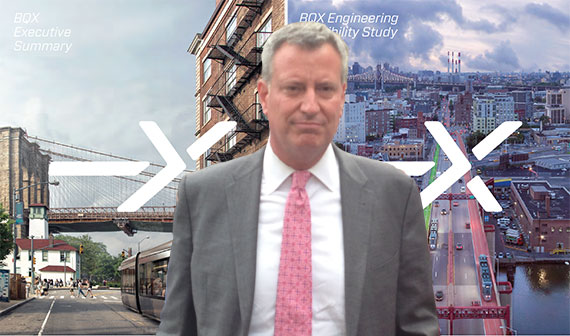Trending
De Blasio turns down streetcar boosters’ offer to split costs
City says it’s working on its own model to fund $2.5B system

Some deep-pocketed early supporters of a streetcar along the Brooklyn and Queens waterfront offered to pay for part of the ticket. But City Hall declined the ride.
Members of Friends of the Brooklyn Queens Connector – the nonprofit established in 2014 to gin up support for the streetcar – proposed the idea of contributing to the cost of the system, according to a study they financed and sent to Mayor Bill de Blasio’s office before he announced his plan for the 17-mile trolley in February.
“This contribution could take the form of a capital contribution or an annual operating grant or subsidy, or the sponsorship of a certain type or class of riders,” read the feasibility study completed last fall, which The Real Deal obtained via a Freedom of Information Law request. “The scale and structure of such a commitment can be determined once the program, timing, and legal and financial structures for the system are better defined.”
HR&A Advisors (City Planning chairman Carl Weisbrod’s former consulting firm), BJH Advisors and Sam Schwartz Engineering conducted the study on behalf of the nonprofit, whose members include real estate players Doug Steiner, Jordan Barowitz of the Durst Organization and Two Trees Management’s Jed Walentas. All three have large development projects that would benefit from a streetcar slinking from Sunset Park to Astoria.
The city, however, said it isn’t factoring private contributions into its funding model.
“There have been no discussions with the report’s authors on this front. The administration has pursued its own modeling and analysis, which differs in many ways from that initial proposal,” Anthony Hogrebe, a spokesperson for the New York City Economic Development Corporation, wrote in an email to TRD. “At this point, we are focused on processing the first round of community feedback and hammering out logistics around possible routes and service.”
A representative for Friends of the BQX wasn’t available for comment, and it’s unclear how much money the members considered parting with.
City Hall believes that the streetcar’s boon to property values will generate between $2.4 and $3 billion in additional tax revenue over 40 years to pay for the system, which it calculates will cost $2.5 billion to build. In addition, the city estimates it will cost $31.5 million each year to operate and maintain the streetcar.
Transportation systems like the streetcar are not typically funded through charitable fundraising. But the nonprofit advocates said they were thinking outside the box with the BQX, and floated the idea of setting up a conservancy similar to the one that provides the overwhelming share of the operating budget for the city-owned High Line Park.
“It is plausible that, depending on the other governance and financial arrangements for the system, an organization similar to the Friends of the High Line could be established and successful in sponsoring events and generating charitable giving to fund BQX operations,” the group’s study read.
The bold transportation proposal is not without its critics, who have argued the streetcar line simply replicates services that could be provided at much lower costs with traditional bus operations. They also contend that the gentrifying areas along the Brooklyn and Queens waterfronts are not the most cost-effective areas to invest transportation resources.
The de Blasio administration says as many as 45,000 public-housing residents would benefit from the streetcar, though critics say the plan ignores the biggest transportation deserts in the city and would largely bring smiles to wealthy developers.
Under the plan, construction would begin in 2019 and service beginning in 2024 at the earliest.




